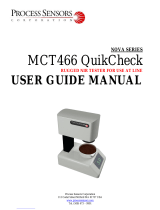Two ¼” mechanically compatible light sources (2 - VIS and NIR) are included in the scope of delivery
of the miniLiquid. The spectra are described later in the document. Other LEDs or light sources can be
used after own modification if the interfaces for the openings in the holder and the optical path are
observed. Light sources are also mounted in the holder openings using the ¼” standard. Different
optical paths (180° transmission or 90° reflection) can be realized via different openings in the holder
(alternatively on each side of the holder). Unused openings in the holder should be closed with the
plugs (5.2) to avoid light interference during measurements.
Sample cuvettes are included in the DK. However, it is very important to match the cuvettes and the
entire optical path to the application - as this determines the accuracy of the measurements and their
results. In the case of liquid measurements, the results are:
1. From the spectral overlap of the spectra of the light source, with the spectrum of the liquid on
the sensor channels in transmission (180°).
2. From the reflection of the light with the liquid and contained particles on the sensor channels in
(90°).
In both modes, it is necessary to take into account the influences of the cuvette when passing through
its walls twice - as well as its various reflections and refractions. Therefore, cuvettes with a surface
prepared for optical measurements are recommended. Note that only two sides of a cuvette may be
pretreated. Take this into account for measurements with the cuvette inserted. The influences of the
cuvette and the optical path should be eliminated using differential measurement. To do this, first
measure the empty cuvette in the setup. Then substitute these sensor values from the sensor results
after measuring the samples in the same setup.
All parts of the DK must be mounted. The light source and the sensor should be prepared to have an
operating temperature, and the assembly should be free from interference. After inserting a cuvette,
the holder should be closed with the cap (4) - to avoid light influences from the environment. Then
proceed with the measurements.
The next chapters further elaborate on some important technical details.















